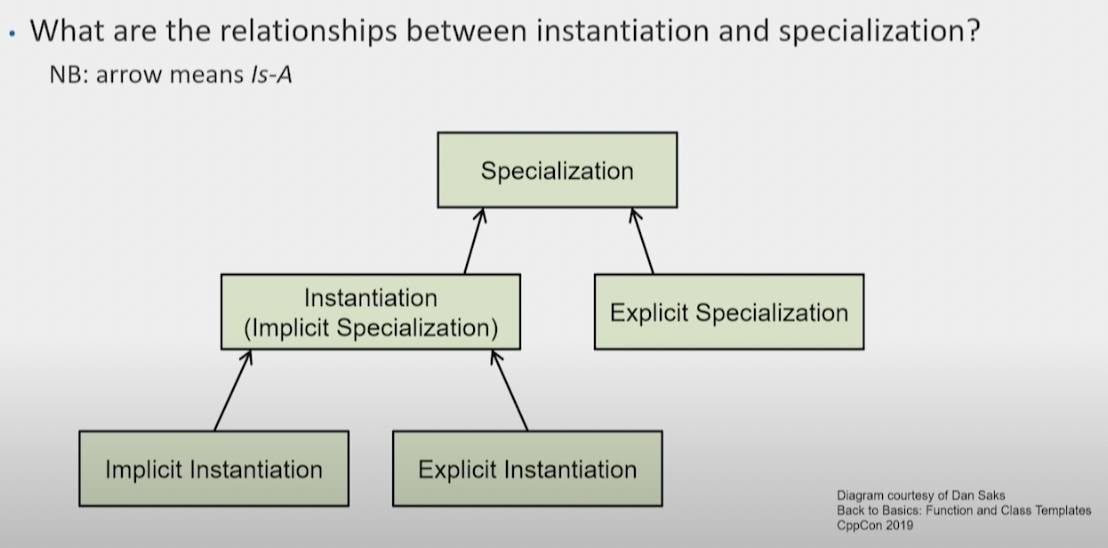模板:函数模板
1 模板的基础知识
1.1 模板的参数

在技术文献中:parameter翻译成形参(format parameter), argument翻译成实参(actual parameter).
A type parameter can be used to name the return type or a function parameter type, and for variable declarations or casts inside the function body. Each type parameter must be preceed by the keyword typename .
点击查看代码
template <typename T> T foo(T* p) {
T tmp = *p;
// ...
return tmp;
}
// error: must precede U with either typename or class
template <typename T, U> T calc(const T&, const U&);
A template nontype parameter is a constant value inside the tempalte definition. A nontype parameter can be used when constant expressions are required, for example, to specify the size fo an array.
点击查看代码
template < unsigned N, unsigned M>
int compare(const char (&p1)[N], const char (&p2)[M]) {
return strcmp(p1, p2);
}
// 如果调用函数如下
compare("hi", "mom");
// 该模板函数会被实例化下面这个函数
int compare(const char (&p1)[3], const char (&p2)[4]) { ... }
1.2 模板的分类
- function template 函数模板 (recipes for making functions)
- class templates 类模板 (recipes for making classes)
- member function templates 成员函数模板(recipes for making member functions of classes)
- alias templates (C++ 11引入) 别名模板(recipes for making type aliases)
- variable templates(C++ 14引入) 变量模板(recipes for making variables or static data members)
- lambda templates (C++ 20引入)

A template is not a thing —— it is a recipe for making things.
2 模板的特化(specialization)
The concrete entity resulting from substituting template arguments for template parameters is a specialization.


下面给几个函数模板特化(Expliciit Specialization)、Implicit Instantiation和Explicit Instantiation的例子。(类模板才有偏特化[Partial Specialization])
点击查看代码
template<typename T>
T const& min(T const&a, T const& b) {
return (b < a) ? b : a;
}
// Explicit Specialization
template<>
int const& min(int const& a, int const& b) {
return (b - 10 < a) ? b : a;
}
double d1 = 2.78;
double d2 = 3.14
// Implicit Instantiation
double d3 = min<double>(d1, d2);
// Implicit Instantiation
double d4 = min(d1, d1)
点击查看代码
#include <iostream>
#include <string>
template<typename T>
T MyMin(const T& a, const T& b) {
return (a < b) ? a : b;
}
// Explicit Specialization
template<>
double MyMin(const double& a, const double& b) {
return 0.112;
}
// Explicit Instantiation
template int MyMin(const int& a, const int& b);
int main() {
int a = 3;
int b = 4;
float x = 1.2;
float y = 1.1;
double m = 1.200;
double n = 2.100;
std::cout << MyMin(a, b) << std::endl;
std::cout << MyMin(x, y) << std::endl;
std::cout << MyMin(m, n) << std::endl;
// Implicit Instantiation
std::string s1 = "hello";
std::string s2 = "world";
std::cout << MyMin(s1, s1) << std::endl;
return 0;
}
3 函数的默认参数
点击查看代码
#include <iostream>
#include <string>
// Function Declaration
int myadd(int a = 2, int b = 3);
int mysub(int a = 6, int b = 3);
// Function Definition
// OK
int myadd(int a, int b) {
return a + b;
}
// Error
int mysub(int a = 6, int b = 3) {
return a - b;
}
int main() {
int x = 10;
int y = 5;
std::cout << myadd(x, y) << std::endl;
std::cout << mysub(x, y) << std::endl;
return 0;
}




【推荐】国内首个AI IDE,深度理解中文开发场景,立即下载体验Trae
【推荐】编程新体验,更懂你的AI,立即体验豆包MarsCode编程助手
【推荐】抖音旗下AI助手豆包,你的智能百科全书,全免费不限次数
【推荐】轻量又高性能的 SSH 工具 IShell:AI 加持,快人一步
· 25岁的心里话
· 闲置电脑爆改个人服务器(超详细) #公网映射 #Vmware虚拟网络编辑器
· 零经验选手,Compose 一天开发一款小游戏!
· 因为Apifox不支持离线,我果断选择了Apipost!
· 通过 API 将Deepseek响应流式内容输出到前端